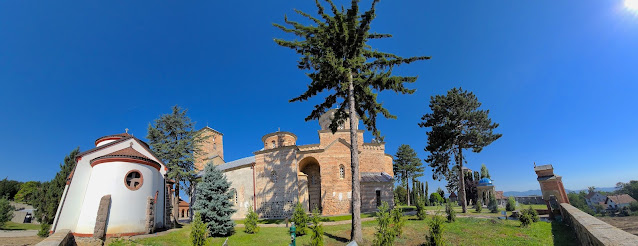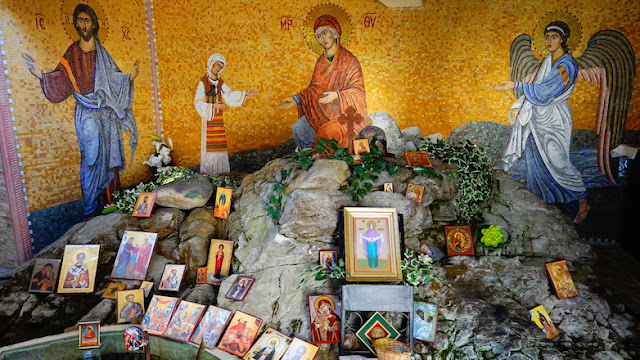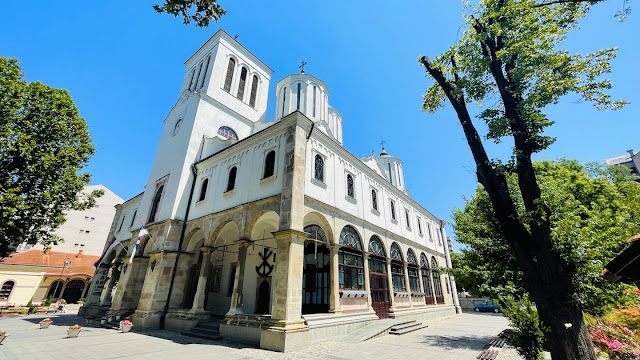This post sees us drive from Kraljevo to Nis in Serbia via Zica Monastery, Krusevac, Monastère de Đunis, Monastery of Saint Roman and the rural town of Aleksinac. We then visit the city of Nis.
Žiča is a Serbian medieval monastery from the first half of the 13th century, which is located near Kraljevo and belongs to the Diocese of Žiča Serbian Orthodox Church. It was built by the first king of Serbia from the Nemanjić dynasty, Stefan Nemanjić from 1206 until 1221. Zica is the traditional village of Sovereigns and as such this Monastery crowned a total of 7 Kings until the time the Ottoman Turks invaded. An amazing page out of history – live before our eyes.
Krusevac (Pop 81,316, Elev 163m, Founded 1371) is another semi-industrial and semi-agricultural city between Belgrade and Nis sporting a very wide boulevard with music and fountains in the middle leading to a very limited pedestrian mall but lots of clothing shops.
Monastère de Đunis further afield has a delightful origin. In 1898, a 13-year-old farm girl grazing sheep and running out of water saw the Virgin Mary who provided her with water from a rock and asked her to build this Monastery on that spot. The Monastery was built in 1934 and renovated in 1977.
The Monastery of Saint Roman also has a special story. The monastery is known for being the residence of a monk by the name of Roman Sinait (or Roman of Sinai), who was later declared a saint, so the monastery, in fact, carries his name. The tomb of Saint Roman Sinait with relics rests in the monastery to this day. He is revered by the people there as a miracle worker and healer. The Sinai monks, followers of Thessaloniki miracle worker Gregory Palamas, accepted his teachings and came to Serbia during Prince Lazar's reign. We were very fortunate to meet the Abbott Fr Nicholas who spoke fluent Greek and offered us a delicious room-temp tea and Rakia. He explained the origins of the Monastery and the life of St Roman. We venerated the relics of St Roman and left with a generous goft of an icon each and a litre of home-grown Rakia (40% spirit distilled from wine).
Enjoy our journey to Nis…
We arrived in Nis in the late afternoon to 36C and decided to rest and see the city in the morning. The dinner that night was one of the best so far. Paris discovered the local restaurant in the darkness of night and we feasted on a traditional meal of stuffed meats, beans and cabbage. Leo pursued a local student dance festival until midnight whilst Paris and I watched Get Smart – I needed an early night ahead of my grand run of Nis at 6am the next day as forecasted temps would reach 36C.
The following morning the city of Nis (Pop 260,237, Elev 195m, Founded 2nd Century) unfolded in splendour. A grand city with plenty of space and a nice pulse about it. Leo and I toured the city whilst Paris has a “day off” eating pizza and looking to replace the headphones he lost. What a loss for Paris since this is the city that St Constantine The Great was born !!!
Leo and I walked the full length of the grand pedestrian walk culminating in the fortress and a disappointing Nazi Concentration camp – totally unkept. Later in the arvo after a pit stop at our unit we saw Skull Tower, a locked up Mediana where St Constantine The Great was born in 272AD. He was crowned Roman Emperor in 306 in York England of all places. Constantine was the first Roman emperor to convert to Christianity. Although he lived much of his life as a pagan, and later as a catechumen, he began to favour Christianity beginning in 312, finally becoming a Christian and being baptised by either Eusebius of Nicomedia, an Arian bishop, as attested by many notable Arian historical figures, or Pope Sylvester I, which is maintained by the Catholic Church and the Coptic Orthodox Church. He played an influential role in the proclamation of the Edict of Milan in 313, which declared tolerance for Christianity in the Roman Empire. He convoked the First Council of Nicaea in 325, which produced the statement of Christian belief known as the Nicene Creed. The Church of the Holy Sepulchre was built on his orders at the purported site of Jesus' tomb in Jerusalem and was deemed the holiest place in all of Christendom. The papal claim to temporal power in the High Middle Ages was based on the fabricated Donation of Constantine. He has historically been referred to as the "First Christian Emperor" and he did favour the Christian Church. While some modern scholars debate his beliefs and even his comprehension of Christianity, he is venerated as a saint in Eastern Christianity, and did much for pushing Christianity towards the mainstream of Roman culture. And it all started in Nis !!!
Skull Tower is a stone structure embedded with
human skulls. It was constructed by the Ottoman Empire following the Battle of
Čegar of May 1809, during the First Serbian Uprising. During the battle,
Serbian rebels under the command of Stevan Sinđelić were surrounded by the
Ottomans on Čegar Hill, near Niš. Knowing that he and his fighters would be
impaled if captured, Sinđelić detonated a powder magazine within the rebel
entrenchment, killing himself, his subordinates and the encroaching Ottoman
soldiers. The governor of the Rumelia Eyalet, Hurshid Pasha, ordered that a
tower be made from the skulls of the fallen rebels. The tower is 4.5 metres (15
ft) high, and originally contained 952 skulls embedded on four sides in 14
rows.
Enjoy the cultural and historical richness of Nis…



































No comments:
Post a Comment